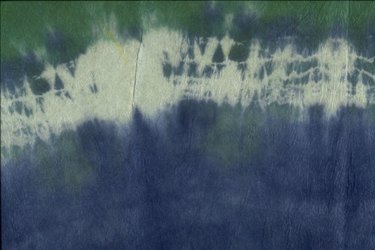Things You'll Need
Fishing line
Needle
Scissors
Sodium carbonate
Water
Bucket
Trash bags
Masking tape
Cardboard
Newspaper
Paper towels
Dye
Dye thickener
Spray bottle
Squeeze bottle
Plastic bag
Detergent

The art of tie-dying differs between cultures but the aim is the same: to create a distinctive piece of artwork or apparel. Whereas many people are familiar with ways to tie-dye circles, starbursts, lines and even peace signs, few have probably tried the more complex art of writing names. The first rule of writing with tie-dye is to keep the pattern simple. Write only in clear block letters, using straight and not rounded lines. This technique works best when you write names along a banner or diagonally across a T-shirt. The extra room allows for larger letters.
Making the Letters
Step 1
Wash fabric before sewing your letters to remove any manufacturer's sizing or treatments. If you wash the fabric after you have sewn in and tied off your letters, the bunched up fabric will not wash or rinse well. Any trapped detergent or fabric treatments will keep the dye from adhering in later steps.
Video of the Day
Step 2
Presoak the fabric in a soda ash solution for 15 minutes. In a bucket, mix 1 cup of sodium carbonate for every gallon of water.
Step 3
Ring the excess water out of the fabric.
Step 4
Use a washable marker to write out the name in block letters on the fabric. Draw the letters at least 3 inches tall. Smaller letters may turn out as fuzzy blobs. Leave at least an inch of space between each letter.
Step 5
Thread fishing line through a needle. Do not cut the line from the spool. Simply unwind a foot or more of line.
Step 6
Start on a single line of a letter and sew two or three stitches for each inch. Pull the fishing line through the fabric as you stitch. When you reach the end of the letter line, cut the thread so that 1 inch of fishing line hangs out of the fabric at either end. Repeat until you stitch each line of the letter. Repeat the process for each letter.
Step 7
Grasp the two ends of a piece of fishing line on a single line of a letter and tie them together tightly, bunching the fabric along the line. Repeat with all fishing line threads for each letter line.
Dying the Fabric
Step 1
Cover the work surface with trash bags and secure them with masking tape. Lay down scrap cardboard, newspapers or paper towels to absorb any spilled dye.
Step 2
Mix the dyes according to the manufacturer's instructions. Mix the dye in a squeeze bottle to control the application. Add a dye thickener such as sodium alginate or Super Clear. The thickener keeps the dye from penetrating deeply into the fabric, preserving the white outline of the letters.
Step 3
Apply the dye to the fabric. Do not stick the tip of the squeeze bottle into the folds of the fabric. This will blur or eliminate the lines of your letter.
Step 4
Place fabric in a plastic bag and allow the dye to cure from 8 to 24 hours. The less time the dye cures, the sharper the white lines will stay, but the final color will be weaker. Experiment with curing times until you find the right balance.
Step 5
Rinse the fabric in cold running water while still wrapped up. Then, cut the threads while holding the fabric under warm running water. Be careful not to cut the fabric. Continue to rinse the fabric until the water runs clear.
Step 6
Wash the fabric in hot water with dye-friendly detergent such as Sythrapol. Do not wash more than eight T-shirts, four dresses or two banners at one time to avoid muddying the water and causing the dyes to deposit back onto the fabric.
Video of the Day